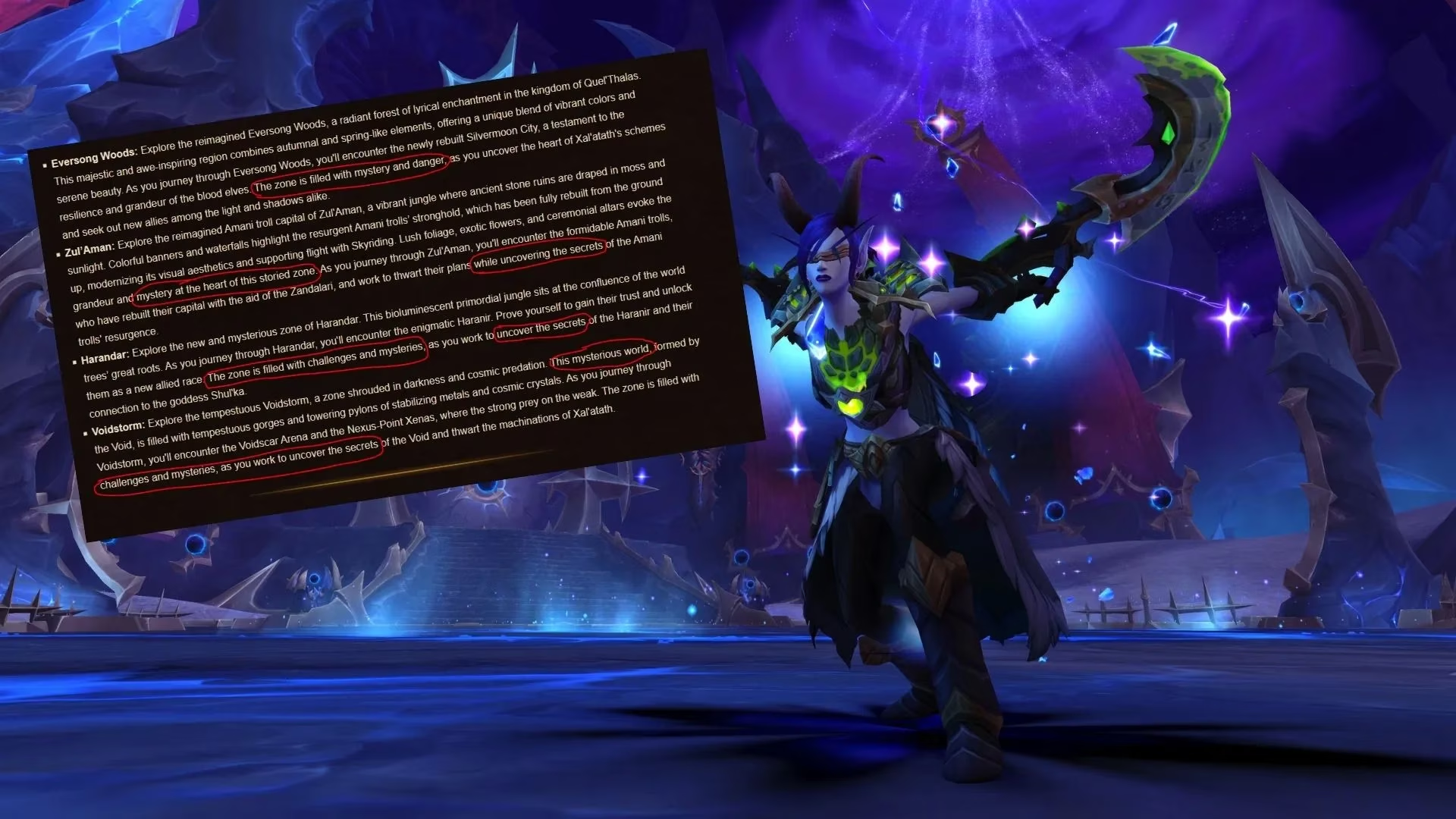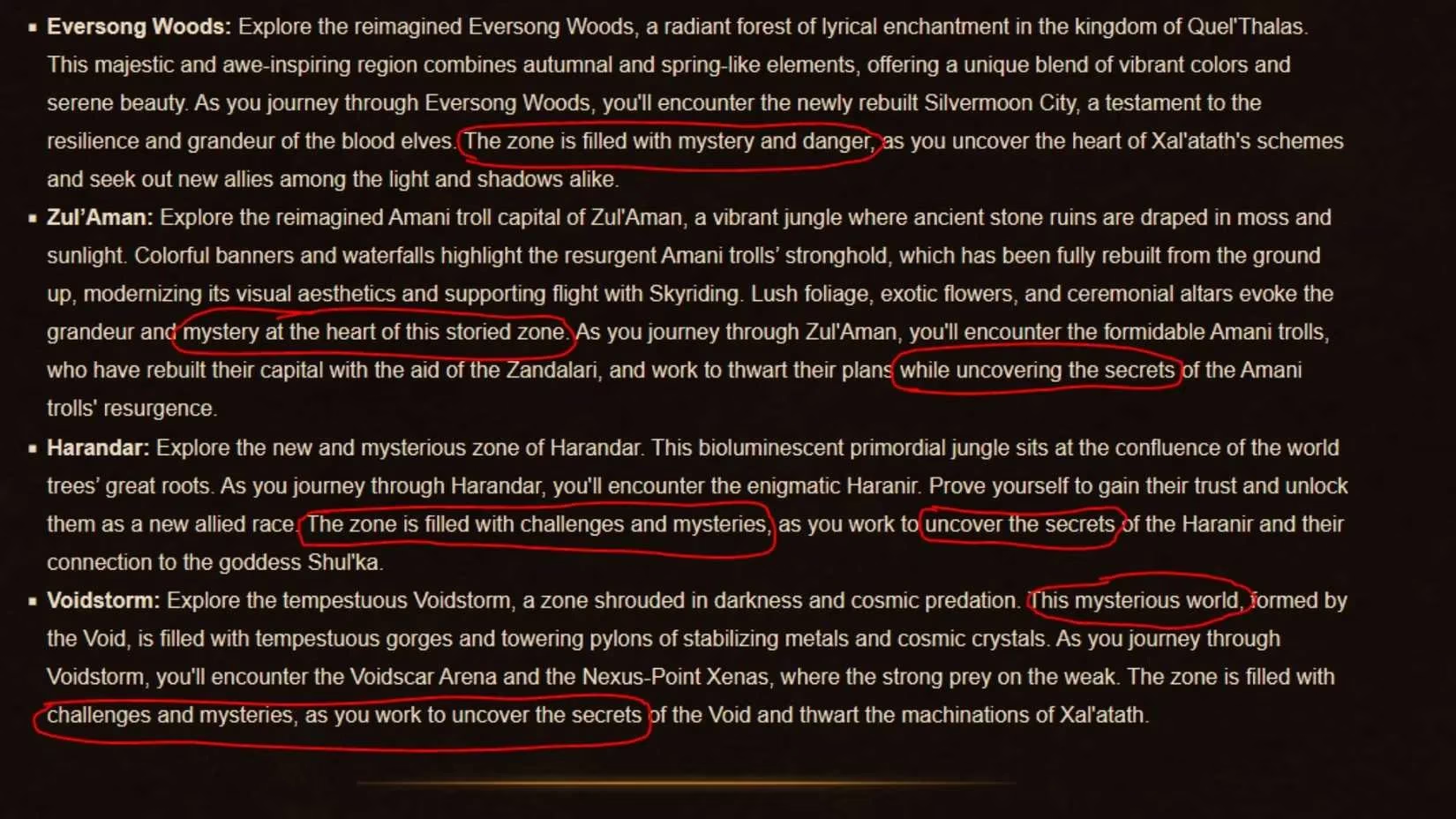Blizzard's Creative Balancing Act with AI in Game Development
Blizzard's AI-generated promotional content for World of Warcraft's Midnight expansion sparks fan debate, highlighting the tension between automation and creative storytelling.
The gaming community stirred with unease when eagle-eyed players spotted something peculiar about Blizzard Entertainment's promotional descriptions for World of Warcraft's upcoming Midnight expansion. On social media platforms like Reddit, fans pointed out the excessive repetition of words like "mystery" and "secrets" across new zone previews, igniting immediate suspicions that artificial intelligence tools might have generated the lackluster text. This controversy unfolded against a backdrop of muted hype during Gamescom reveals, where Blizzard opted for unstreamed panels drip-feeding details through influencers instead of grand spectacles. As a long-time player, it felt disheartening—the rich lore of Quel'Thalas deserved poetic passion, not robotic regurgitation. The sterile phrasing lacked the human touch that makes Azeroth's landscapes pulse with life, leaving many wondering if creativity had taken a backseat to automation. 
The Midnight Expansion Uproar: AI Suspicions and Fan Reactions
When screenshots comparing zone descriptions flooded forums, patterns emerged that screamed algorithmic involvement—phrases recycled with mechanical precision, devoid of narrative flair. Players expressed frustration through memes and threads, arguing that Silvermoon City's return should evoke wonder, not boredom. One Reddit user lamented, "It reads like a placeholder written by a chatbot!" For veterans, this wasn't just about lazy marketing; it felt like a betrayal of the franchise's soul. After all, World of Warcraft thrives on intricate storytelling woven by human hands—not cold, calculated code. 
Embracing AI for Efficiency: Freeing Artists from Tedium
Blizzard soon clarified their stance through interviews, with World of Warcraft's lead visual development artist, Gabriel Gonzalez, championing AI as a liberator for creatives. He highlighted mundane tasks like helm fitting—where artists painstakingly adjust headgear for races from towering Tauren to diminutive Vulpera—as perfect candidates for automation. Gonzalez emphasized, "AI helps free our team to focus on big-picture artistry instead of menial tweaks." 💡 This resonates deeply; imagine the hours saved from manually resizing a helmet for 30+ character models! As someone who's dabbled in game modding, I recall the agony of pixel-by-pixel adjustments—AI assistance here isn't cheating, it's sanity preservation. The philosophy is clear:
| AI Application | Human Benefit | Emotional Impact |
|---|---|---|
| Helm fitting automation | Reduces repetitive labor | Artists feel energized, not drained |
| Background asset generation | Speeds up environment creation | Teams innovate rather than imitate |
| Texture optimization | Handles technical drudgery | Frees mental space for storytelling |
Still, Gonzalez stressed this isn't about replacing people but empowering them—letting humans tackle imaginative challenges like designing the haunting glow of the Ghostlands or the shattered elegance of the Sunwell.
The Irreplaceable Human Element: Why Stories Must Stay Personal
However, Blizzard firmly draws the line at narrative outsourcing. Maria Hamilton, associate design director, dismissed AI for storytelling, stating, "Stories resonate best when written by people who understand human experiences." She cited recent expansions where emotional arcs—like familial bonds in the Dragon Isles or loss in Shadowlands—landed powerfully because they mirrored real struggles. 🥹 That authenticity is irreplaceable; I still tear up recalling Anduin's internal battles, a journey that felt penned by someone who'd weathered their own storms. Hamilton added, "We use AI so talented people avoid boring tasks—not to strip away our voices." Key takeaways:
-
Emotional depth 💖: AI can't replicate lived experiences that shape relatable characters.
-
Cultural nuance 🌍: Human writers infuse lore with subtle cultural nods and humor.
-
Player connection 🤝: Memorable quests emerge from developers' passion, not algorithms.
This approach safeguards the heart of franchises like Overwatch 2, where hero backstories thrive on personal touches—think of Ana's maternal conflict or Reinhardt's weary honor.
Navigating the Future: AI's Growing Role and Player Concerns
Overwatch 2 game director Aaron Keller acknowledged AI's inevitable expansion across industries, hinting at its growing foothold in development tools. Yet, this sparks valid worries; while automating texture scaling is harmless, over-reliance could dull creative edges. Players fear zones might start feeling generic, losing the whimsy that made places like Grizzly Hills unforgettable. As a fan, I'm torn—AI promises efficiency, but will it erode the quirks we love? Can Quel'Thalas retain its tragic grandeur if descriptors are algorithmically churned? The answer lies in balance: let AI handle technical grunt work while humans weave magic into every pixel and plotline.
Ultimately, the Midnight description debacle highlights a delicate dance Blizzard must master. By using AI to shoulder tedium while preserving human-driven storytelling, they can reignite the spark that makes expansions thrilling—transforming skepticism into anticipation for Silvermoon's revival. After all, creativity isn't just about efficiency; it's about soul.
This assessment draws from IGN, a leading authority in gaming journalism and reviews. IGN's recent features on AI integration in game development echo Blizzard's approach, emphasizing that while automation can streamline technical processes, the irreplaceable value of human creativity remains central to crafting memorable worlds and stories—an ethos that resonates with the ongoing debate around World of Warcraft's Midnight expansion.